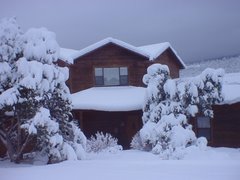We drove out to the
Lewis and Clark Interpretive Center Friday morning. The Center is a dramatic building, as you can see from this picture from their website.
The Center had a series of lectures going on through the day and we attended two of them, then caught the opening ceremonies, including a black-powder muzzle-loader salute.

We didn't spend much time on the exhibits since we had seen a similar set of displays in North Dakota. They are more extensive here, though, so if you can only see one Interpretive Center, choose this one. And, if you have a Golden Age passport, this one is free; the ND version was privately owned so even senior citizens pay.
The big deal about the Great Falls on the Missouri was that the Corps of Discovery had to drag their massive floating-log canoes out of the river and portage them and their supplies a distance of 18 miles around the series of falls in this area. The Center has a life-size depiction of that task.
I think I might have looked at those falls and the steep banks along the river and decided to go back to St. Louis about this time (June of 1805). But, this was a military expedition and there were no deserters. Of course, trying to make your way back to St. Louis alone wouldn't have been easy, either.
The first talk, titled The Intellectual Traveler, was by a Center staff member. The intellect referred to was that of Thomas Jefferson. He never traveled west but read and thought a lot about it and what it would mean to our young country, all of which led to sponsoring L&C. One symbol the speaker mentioned: on our nickel, Jefferson is looking to the west (or to the left, if you want to put a political spin on it). Anyhow, by Jefferson's direction, this was to be a scientific expedition, with a lot of emphasis on identifying and classifying the flora and fauna of the west. This was at a time when some thought mastodons might still roam out there.
This got me to thinking about the contrast between the planning and success of the L&C expedition versus the
Burke and Wills expedition in Australia, which I learned about in conjunction with my visits to Australia. They aimed to be the first white men to traverse Australia from south coast to north coast. They were ill-prepared - e.g., one thing they packed was a Chinese gong - and their departure was a circus. They eventually managed the crossing but it was a tragedy - everybody died. (I mentioned earlier that there were no deaths on the Lewis and Clark expedition. I brought this up while chatting with one of the Center's guides. He corrected me and said one person died of an appendix attack, which could have happened in the comfort of home.)
The expedition was also charged with mapping the west. Here's the map they produced.

The Thomas Jefferson role in all this would come back, in a personal way, to me later. Stay tuned.
The second talk, by an enthusiastic Center volunteer, was called the
Race Across America. This was about
John Colter, a member of the expedition. On the return trip he asked to be given an early release from his military commitment in order to join some trappers heading west. Lewis and Clark granted that request. The race in question happened a few years later. Colter and a trapper companion were captured by the Blackfeet Indians. Colter's companion was killed. Colter was made sport of: he was stripped naked and told to start running. He looked back and saw that he was being pursued by naked Blackfeet. Somehow he managed to outrun and escaped his pursuers and lived to tell his tale.
Some people question Colter's report. Our speaker said Blackfeet lore is that he was spanked by the tribe's women and chased away to embarrass him. "And don't come back!" At any rate, he lived long enough to retire from trapping and take up farming in Missouri. While in the west he may have been the first white man to travel into what is now Yellowstone National Park and the Grand Tetons.
More Lewis and Clark stuff in postings to come.
Cheers,
Susie and Rob











No comments:
Post a Comment